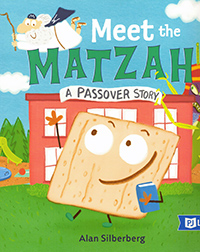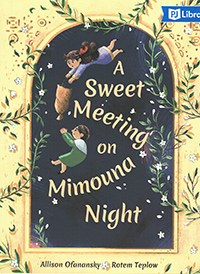
 Meet the Matzah: A Passover Story by Alan Silberberg; New York: Penguin Random House; © 2021; ISBN 9780593-526613; 34 pages plus summary of Passover ad glossary; free via PJ Library.
Meet the Matzah: A Passover Story by Alan Silberberg; New York: Penguin Random House; © 2021; ISBN 9780593-526613; 34 pages plus summary of Passover ad glossary; free via PJ Library.
A Sweet Meeting on Mimouna Night by Allison Ofanansky, illustrations by Rotem Teplow; Toronto and Berkeley: Groundwood Books, House of Anansi Press © 2020; ISBN 9781773-068237; 33 pages plus summary of Mimouna and a recipe for Moufletot; free via PJ Library.
From PJ Library comes two Passover-related books suitable for reading to children. Meet the Matzah is the kind of silly story that children will giggle over. In this case, different kinds of breads and matzah have been anthropomorphized as students in a classroom where they learn about all kinds of holidays and the breads that are served. For example, one might eat naan during the Hindu festival of Diwali and tortillas on the Mexican holiday of Dia de los Muertos.
Today, however, the one who is making a presentation to the class is Alfie Koman (get it?) whose duty is to describe Passover and matzah. At first Alfie Koman can’t be found because he was hiding in the bookcase. His friend challah helps him to the front of the class, but he is immediately heckled by “Loaf” the sourdough, who considers all these holiday stories boring.
So, Loaf tries to improve the traditional Passover story. Instead of Pharaoh, he renames the villain of the piece, Pha-Roach. He makes the super-hero of the story “Mighty Moses,” who like Superman, can fly. He delivers 10 plagues against pharaoh, among them No Wi-Fi, early bedtime, and indoor recess forever. Unable to bear the true story of Passover being ruined, Alfie finds his courage and his voice to silence Loaf and tell the real story of Passover, which the students and their teacher, Mrs. Crust, find fascinating. Even Loaf enjoys the story, and to show that there are no hard feelings Alfie invites Loaf to his seder.
Of course, being a form of chametz, Loaf is required to attend in a hermetically sealed space suit so no leavening will be inside the house.
 In A Sweet Meeting on Mimouna Night, little Miriam who lives in Fes, Morocco, goes with her mother on the night following the last day of Passover to the home of her Muslim neighbor. Jasmine is her age. After sharing some tea, Jasmine’s mother gives a sack of flour to Miriam’s mother. The flour is needed to make a form of pancakes known as moufletot for a Mimouna party celebrating the end of Passover and wishing all a good year.
In A Sweet Meeting on Mimouna Night, little Miriam who lives in Fes, Morocco, goes with her mother on the night following the last day of Passover to the home of her Muslim neighbor. Jasmine is her age. After sharing some tea, Jasmine’s mother gives a sack of flour to Miriam’s mother. The flour is needed to make a form of pancakes known as moufletot for a Mimouna party celebrating the end of Passover and wishing all a good year.
Everyone in the neighborhood – Jews and Muslims – are invited to the party. Jasmine comes with her parents, and everyone enjoys the playing of a song “Alaila Mimouna” to the accompaniment of musical instruments. Hits of the evening are the golden-brown moufletot spread with butter and jam. Overcoming their shyness, Miriam and Jasmine become friends.
The party goes from one house to another, including one where a man dips a stalk of green wheat into milk and sprinkles it onto the heads of those in attendance. “Next year in Jerusalem!” he intones. But this is not simply a ceremonial saying. Like Miriam’s uncles before them, Miriam and her family travel by ship to Jerusalem, where they make their new home. The following year at Mimouna, Miriam remembers her friend Jasmine.
*
Donald H. Harrison is editor emeritus of San Diego Jewish World. He may be contacted via donald.harrison@sdjewishworld.com